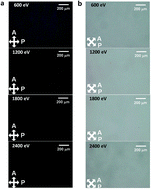Hysteresis-free liquid crystal devices based on solution-derived oxide compound films treated by ion beam irradiation
Abstract
Compounds with a high dielectric constant (high-k compounds) offer fast response times and low threshold voltages, but are limited by capacitance hysteresis. In this study, we successfully demonstrated high-performance liquid crystal (LC) devices without capacitance hysteresis, using ion beam (IB)-irradiated Hafnium Tin Oxide (HfSnO) films as an alignment layer and controlling the IB intensity. The HfSnO films were prepared using a simple, cost-effective solution process. Atomic force microscopy and X-ray photoelectron spectroscopy were performed to elucidate the LC alignment mechanism. The LC alignment state, pretilt angle, electro-optical performance, and capacitance hysteresis were evaluated as a function of IB intensity.


 Please wait while we load your content...
Please wait while we load your content...